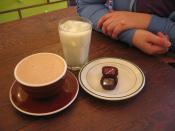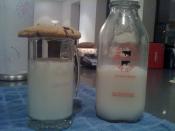Paul Robson �
Dairy Milk Processing
Whole milk is clarified, separated for the lower fat milk, pasteurized, and homogenised. The fat left from the separation is used for cream, butter, sweetened condensed milk, ice cream and other milk products.
The primary objective of processing milk is to extend the milk's shelf life and eliminate pathogens that could be harmful. Heat treatment is the most common processing technique and pasteurisation destroys the most heat resistant pathogen, M. tuberculosis.
Centrifuges are used in dairy processing to remove the globular milk fat from the serum, the skim milk. This normally takes place at a temperature between 50-60úC. The globular milk fat in this case is the residue (left in the centrifuge), and the filtrate is the skim milk (passes out of the centrifuge).
The centrifuge consists of up to 120 discs stacked together at a 45 to 60 degree angle and separated by a 0.4
to 2.0 mm gap or separation channel. Milk is introduced at the outer edge of the disc stack. The stack of discs has vertically aligned distribution holes into which the milk is introduced. (See schematic on next page).
Under the influence of centrifugal force, the fat globules (cream), which are less dense than the skim milk, move inwards through the separation channels toward the central axis of the centrifuge. The skim milk moves outwards and leaves through a separate outlet in the machine.
Centrifugation is based on Stoke's Law . Centrifuge separation is used mainly to separate liquids from solids in a way that is similar to, but faster than, filtration. Centrifuge separation works generally due to difference in particle size, density, viscosity, and state of matter (solid, liquid, or gas).
Centrifugal separation is often used in the dairy industry. Some uses include clarification (removal of solid impurities...



Chemistry Research Task - Dairy Milk Processing
This is an impressive essay. It tries to discuss a rather technical process, without the aid of diagrams or other visual aids, and it succeeds. I am impressed at the amount of information that was conveyed, and the clarity with which it is set forth. Well done.
1 out of 1 people found this comment useful.